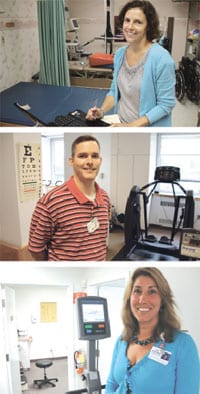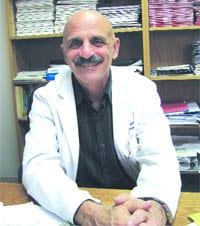Balancing Act Vestibular Therapy Offers Relief for Patients Suffering from Vertigo and Dizziness
Lisa Blain says patients who need vestibular therapy can often be frightened and confused as to the source of their symptoms, which range from vertigo and dizziness to lack of balance.
“Someone might go many months without getting an accurate diagnosis; they feel like they’re going crazy, or have a tumor,” she told the Healthcare News. “It’s not like a broken arm, walking around with a sling. People can’t always see that you have this problem. There are a lot of emotional side effects. Because, if you aren’t sure what is wrong with you, and you’re having these sensations, a lot of people immediately think the worst.”
According to Blain, the lead occupational therapist at the Weldon Rehabilitation Hospital, part of Mercy Medical Center in Springfield, oftentimes, once a patient’s history is coupled with a diagnosis from a primary-care physician, she can provide relief for these most disorienting symptoms.
Vestibular disorders come in all shapes and sizes, said Dr. Theodore Mason, from Ear, Nose & Throat Surgeons of Western New England, where he is a specialist in neuro-otology — the study of the ear. “If a patient comes to me with a sensation of dizziness,” he said, “often after a long discussion and exam, I’m able to determine which type of treatment is going to be best to help with their symptoms.”
And very often, that course of treatment is vestibular therapy. While there are three primary factors contributing to a healthy sense of balance, within the ear, the eye, and the brain, even a slight imbalance in any one of the three can have dramatic consequences.
One of the most common causes, said Brian Tierney, is benign paroxysmal positional vertigo, or BPPV. Tierney is a physical therapist at Holyoke Medical Center, specializing in vertigo, and he said that, when a patient manifests the symptoms of BPPV, which is caused by dislodged calcium crystals in the inner ear canals, the course of action is clear, and often immediate.
“If they truly have BPPV, the majority of these patients are better after one visit,” he explained. “After I see them for an initial, hour-long consultation, and then treat them for it appropriately, they might not even need to make another appointment.”
But the causes for vestibular problems are still many, and complex. This month, HCN spoke with health care professionals who perform the balancing act known as vestibular therapy, who spelled out the symptoms and treatment regimens for many disorders. And while the origins of dizziness and vertigo aren’t always immediately clear, the course of treatment is.
As Pam Cavanaugh, physical therapist and lead ‘balance expert’ at Cooley Dickinson Hospital, said, “once we know how to proceed, and have an understanding of the causes for someone’s symptoms, we go forward to alleviate the discomfort. With BPPV, it should be better in four treatments, but sometimes it’s better in one or two. They think we’re rock stars!”
A Matter of Perspective
The causes of dizziness and vertigo can be targeted to specific injuries, such as head trauma or upper respiratory infections, but sometimes the onset can be less clear. Sometimes, as Mason said, “the elderly will simply have a dulled vestibular system. And thus, the different therapies can help to sharpen things up a bit.”
Commonly, a patient will be referred to a vestibular therapist by their primary care physician, an ENT specialist such as Mason, or, in acute cases of discomfort, an emergency-room physician. Those first steps in determining a patient’s history are a crucial component in helping to target the correct therapy options, Blain said.
“It’s a very thorough history of the patient telling you what their symptoms are,” she said, “and what course of medical action has been taken prior to getting here. Some people just have a gradual, insidious onset of symptoms, and they happen to mention it at the doctor’s office.
“Others have an acute onset — spinning, dizziness, hitting the floor, and they will arrive to the ER via ambulance,” she continued. “After they’ve ruled out any central causes, like stroke, tumors, things like that, then they get sent to us to see if it’s an inner-ear problem. But those steps that have been taken before they come to us are really critical to know.”
That interview is crucial for therapists to determine what exactly the patient’s own definition of dizziness is. Specifics are important, Cavanaugh said. “When it occurs, we need to know how frequently, how long it lasts, if it’s a spinning sensation or a rocking sensation, if it’s inside your head, or if it’s the environment around you. All those are signs of where to start looking and where to begin treating.”
BPPV is most commonly the cause of the more acute symptoms of vertigo and imbalance. It is estimated that 20{06cf2b9696b159f874511d23dbc893eb1ac83014175ed30550cfff22781411e5} of vestibular episodes are linked to the disorder. For patients under 50, most occurrences are thought to have an origin in head trauma, but for the elderly, it can simply be a degeneration of their vestibular systems.
Accurate diagnosis is made based on the patient’s history and a series of tests upon initial consultation with the therapist. “BPPV does not show up on an MRI,” Blain said, “so we evaluate it by putting the patient’s head in a couple different positions with respect to gravity. We’re looking for two things — one, if they feel dizzy, and we observe for abnormal eye movement, called nystagmus. The direction of the nystagmus indicates to us which of the canals is affected and which ear is affected.”
To treat BPPV, a series of movements is made with the patient’s head while he or she lies down, the therapist slowly turning it in different directions based on the locations of lodged crystals in the specific inner-ear canals. The symptoms will often be alleviated in that first visit, although some may require an additional series of sessions.
“If they come to me soon after the onset of the symptoms of BPPV,” Tierney said, “there’s a greater chance that it will be an easier remedy to the problem.
“If they’ve had this for quite a while — and I’ve had a patient come to me who had the symptoms for more than 20 years — your body starts to adapt to the problem,” he continued. “When you suddenly take the debris from the canal, the fluid moves at full speed, and so for a few days, they may feel a bit off until their body gets use to the full use of their vestibular system.”
Even with successful removal of the crystals, BPPV does have a recurrence rate of 30{06cf2b9696b159f874511d23dbc893eb1ac83014175ed30550cfff22781411e5} after one year, and 50{06cf2b9696b159f874511d23dbc893eb1ac83014175ed30550cfff22781411e5} within five years. Tierney said that one of his goals is to teach his patients the movements he used on them in their therapy.
“Some patients can’t do them,” he explained, “but if I think they can do it on their own safely, then they can attempt this for a couple times a day, and if that doesn’t work, they can return to their doctor, and perhaps come back to me.”
Coordinated Effort
But not all vestibular disorders are so easily assessed. Tierney listed a series of other conditions all conspiring to throw people off balance, literally, including Ménière’s disease, acoustic neuroma, perilymph fistula, migraines, multiple sclerosis, and herpes zoster.
Vestibular neuritis, also known as labrynthitis, is one of the more common problems. “It is believed to be a result of an upper respiratory virus that affects the nerve and causes inflammation to the eighth cranial nerve,” he said. “So you’ll have a decreased signal going from one side of the body to the brain, and it will make you feel like you’re spinning. It’s a sudden onset and can last for several days. The majority of people who get this will not be able to walk; they’ll be nauseous, vomiting, and they’ll be calling 911 and ending up in the hospital.”
Visual sensitivity is pronounced with labrynthitis, and often something as simple as moving their hands while they talk can make the patient nauseous. “They can’t watch CNN with the streaming banners moving across the TV, or go to a movie,” Cavanaugh said. “They might have a hard time even riding in the car.
“We give those folks a series of graded exercises to promote eye-head coordination and gaze stabilization,” she continued. “The way your eyes and head work together, if I’m staring at something — say, a letter on the wall — I should be able to turn my head 20 degrees to the side and my eyes subconsciously rotate to fixate on that. If that ratio is off, so that if you turn your head, it doesn’t match, we can retrain that gaze-stabilization feature. We start at a very calm environment, maybe seating at first, slowly, but then, as you progress, you can move your head more quickly, or while walking.”
Back in Balance
Ultimately, vestibular therapy for this wide range of specific disorders encompasses physical manipulation, eye-movement exercises, and sometimes specialized pieces of machinery, to focus eye coordination while the body is in motion. And while all therapists have their own desired outcomes for their patients, most agree that the goal is zero dizziness. Traditional PT might take place consistently within the therapist’s office, but often, vestibular therapy involves homework assignments.
“We do a lot of instruction for folks at home,” Blain said. “Because we’re not always going to see a lot of progress in one session here, they are going to need to go home and do this several times throughout the day, every day. And when they come back, I can see progress and bring them to the next level.
“It’s not like the traditional therapy,” she continued. “More commonly, I’m seeing folks once a week and then sending them off to do things on their own.”
The amount of information available on the Internet has also helped to alleviate those fears of the worst-case scenario, said those we spoke with.
“People are coming in more informed,” Cavanaugh said, “but there is a vast amount of information out there on various disorders. So, if anything, people might think they have one thing when they really might have another.”
And while the causes of dizziness are many, the good news is that vestibular therapy often meets the therapist’s baseline goal of diminished symptoms.
“Functionality in your day-to-day routine is important,” said Cavanaugh. “Our goal is the resumption of the patients’ daily activities.”



Comments are closed.